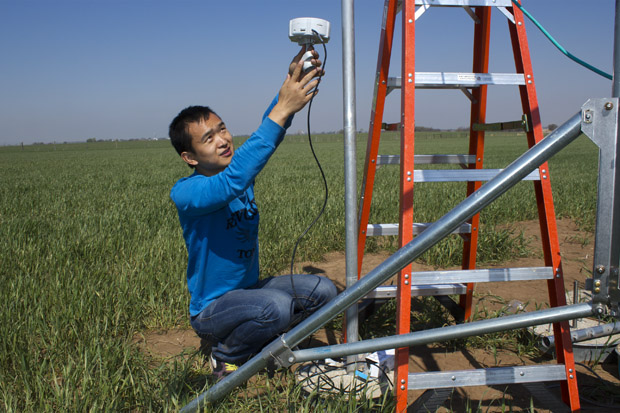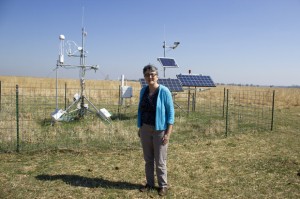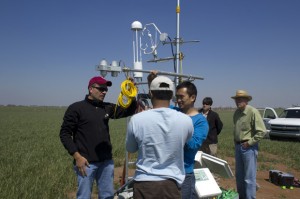
Caption
Joe Wertz / StateImpact Oklahoma


Caption
Joe Wertz / StateImpact Oklahoma

Joe Wertz / StateImpact Oklahoma
University of Oklahoma Ph.D. student and research assistant Yuting Zhou installs a sensor in an experimental wheat field at the Grazinglands Research Lab in El Reno, Okla.
Oklahoma is known for its wild weather. And now, the state’s variable climate is helping scientists understand how climate change could affect farms everywhere.
The federal government recently picked an agricultural laboratory in El Reno to be one of seven regional hubs to study climate change. It turns out, climate change research has been happening in Oklahoma for decades.

Joe Wertz / StateImpact Oklahoma
Jean Steiner, director of the U.S. Department of Agriculture's Grazinglands Research Laboratory in El Reno, Okla., stands in front of a sensor array.
“If you work on agricultural production in the Great Plains, I think you’re going to have to have a strong climate focus at some point in time,” says Jean Steiner, the lab’s director, adding that Oklahoma is the perfect place to do research on the relationship between climate and crops and livestock. “Well, we have such rapid changes between very hot, very cold, very wet, very dry. Within the state, in the same year, you can have severe drought in one part of the state and flooding somewhere else.”
In one of the research pastures on Grazinglands’ sprawling, 7,000 acres, scientists from the University of Oklahoma, including Jeff Basara, are putting the finishing touches on a complex sensor array in the middle of an experimental wheat field.
“This is the interface between the land surface and the atmosphere,” Basara says. “The types of measurements that we’re taking are monitoring the flux of water and carbon and methane between the land surface and the atmosphere. And that’s real important for understanding — really one of the most important variables in all of this is water.”
There are about 40 scientists at Grazinglands studying how climate affects crops, livestock, soil and water. Basara’s team is installing sensors to help determine which tilling practices are more efficient, how livestock feed can be altered to reduce methane emissions, and which strains of grazing grass are the most drought resistant.
All of this research involves climate change.

Joe Wertz / StateImpact Oklahoma
University of Oklahoma meteorology professor Jeffrey Basara installs equipment in a wheat field (left) with the help of postdoc researcher Pradeep Wagle and Ph.D. student Yuting Zhou, as other Grazinglands scientists look on.
“There’s really solid agreement that we’re going to see some warming in this region,” Basara says. “Just a little bit of warming in the atmosphere will have an effect on evaporation. And how does that affect all these other systems?”
Steiner says the research happening in Oklahoma can be applied to other parts of the globe as shifts in weather patterns become more common.
That’s one of the main reasons Grazinglands was picked for the climate hub program, which is basically an initiative to get useful research information already being gathered across the region to farmers and ranchers in a more streamlined way.
“Sometimes it just seems like, well what can you do? You can’t control the climate,” Steiner says. “But if you understand the patterns and the risk a little better, you might be able to come up with management practices that are more flexible, that give you more options when going into a drought, or manage to be more productive in the favorable seasons.
She says the farmers and ranchers she talks to understand climate variability, but not the current cause of it.
“There’s still some resistance to attributing climate patterns to the change in the atmosphere that’s being driven by fossil fuel use primarily,” Steiner says. “It’s also presented in the press as more controversial than I believe it to be.”